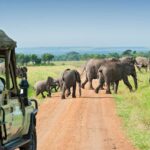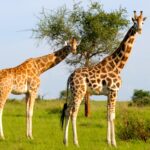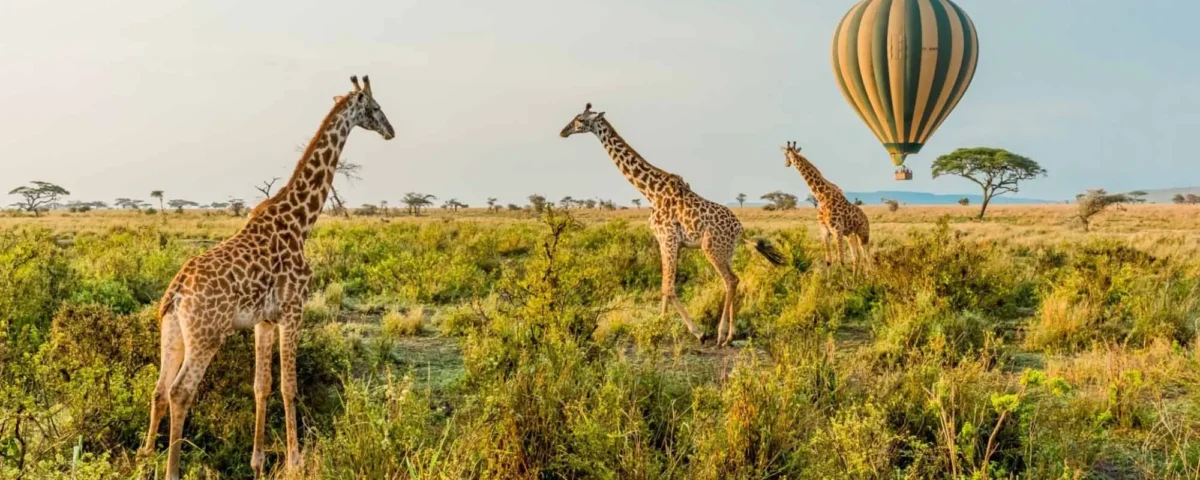
Game Drives in Uganda
July 1, 2025
Where to Spot Giraffes in Uganda
July 1, 2025When to Visit East Africa for a Safari?
Introduction – Planning the Perfect Safari with Nkofu Africa Safaris
One of the first questions travelers ask is “When to Visit East Africa for a Safari?” At Nkofu Africa Safaris, we know timing is crucial. A well-scheduled trip can make the difference between good sightings and unforgettable wildlife memories. East Africa offers diverse options—from Murchison Falls Safaris in Uganda to Gorilla Trekking in Bwindi and Chimpanzee Tracking in Kibale. Whether you’re dreaming of a classic wildlife safari, an immersive Uganda safari, or an extended Rwanda safari culminating in Gorilla Trekking Rwanda, knowing when to go ensures optimal wildlife encounters, comfortable weather, and enriching cultural experiences. In this guide, we explore When to Visit East Africa for a Safari?, matching seasons with safari highlights, weather, animal behavior, and regional experiences across Uganda and Rwanda.
Understanding East Africa’s Seasons and Safari Planning
Seasonal Patterns Across Destinations
“What to Visit East Africa for a Safari?” begins with understanding the two main seasons: wet (March–May, October–November) and dry (June–September, December–February). During dry months, wildlife congregates around limited water sources, improving viewing at places like Murchison Falls National Park and Queen Elizabeth. Dry trails also make Gorilla Trekking Uganda in Bwindi and Chimpanzee Tracking in Kibale accessible and comfortable, while birdwatchers delight in abundant species e.g., Shoebill in Murchison Falls Safaris.
Wet seasons bring lush greenery, fewer tourists, and dramatic landscapes — ideal for those seeking solitude, vibrant birds, or romantic tree canopy visits. Despite heavier rains, Nkofu Africa Safaris ensures thoughtful itineraries that adjust around local weather patterns for a smooth and rewarding safari experience.
Best Time for Wildlife Safari at Murchison Falls
Wildlife Encounters and Birding Highlights
When to Visit East Africa for a Safari? with a spotlight on Murchison Falls Safaris is compelling. This region sees its best wildlife viewing during June to September, when migrating animals gather at rivers and plains. Boat cruises on the Nile reveal hippos, crocodiles, and iconic birds like the Shoebill and Goliath Heron.
December through February offers similar conditions with pleasant warmth, perfect for sundowner game drives and night safaris. Nkofu Africa Safaris curates tailored programs incorporating boat rides to the falls, cultural visits to Banyoro and Alur communities, and upgraded birder-friendly excursions, providing a multi-layered safari adventure.
Prime Season for Gorilla Trekking Uganda in Bwindi
Dry Seasons for Comfortable Treks
If Gorilla Trekking Uganda is your goal, the question of When to Visit East Africa for a Safari? becomes more specific. Dry seasons—especially June to September and December to February—offer optimal trekking conditions. Bwindi trails are firm, less slippery, and guide visibility is better.
During these months, lodging near Bwindi is in high demand, so timely bookings through Nkofu Africa Safaris are essential. Cultural add-ons, such as Batwa pygmy experiences or village visits with the Bakiga, enhance your trek, weaving human context into the natural splendor.
Chimpanzee Tracking and Birdwatching in Kibale
Balancing Wildlife and Ornithology
For those planning a wildlife safari with chimp encounters and birding, consider Chimpanzee Tracking in Kibale Forest. The dry-season months ensure both accessible trails and vibrant wildlife. Birders delight in the Albertine Rift endemics—Green-breasted Pitta, Papyrus Gonolek—while primate enthusiasts witness chimps in action.
Nkofu Africa Safaris schedules your time to combine Chimpanzee Tracking, forest birdwatching, and cultural excursions like Bigodi Wetland Sanctuary walks—providing holistic insight into forest ecosystems and local livelihoods.
Optimal Timing for Rwanda Safari and Gorilla Trekking Rwanda
Cross-Border Wildlife Itineraries
If you’re seeking a crossover Rwanda safari, especially with Gorilla Trekking Rwanda, the same dry-season windows apply (June–September, December–February). Volcanoes National Park becomes accessible, gorilla trails firm, and sightings more reliable.
Nkofu Africa Safaris ensures smooth logistics between countries—arranging cross-border transfers, permits, and forest lodge stays. This timing also allows optional activities like golden monkey tracking or canopy walks in Nyungwe.
Wet-Season Advantages – Green Landscapes & Lower Prices
Quiet Safaris for Bird & Nature Lovers
Contrary to popular belief, wet seasons offer distinct safari benefits. If you’re asking “When to Visit East Africa for a Safari?”, consider the quieter March–May or October–November periods. Trails are lush, temperatures mild, and crowds minimal.
Birding is exceptional as migratory species arrive and woodland birds breed. Waterfalls are full, and eco-lodges near gorilla and chimp habitats offer discounted rates. Nkofu Africa Safaris crafts respectful wildlife itineraries that avoid muddy roads and leverage cultural evenings for rich evenings in the forest.
Cultural Highlights Across the Calendar
Festivals, Customs, and Seasonal Activities
Culture enriches wildlife travel. Whether it’s interwoven with the question When to Visit East Africa for a Safari?, seasonal community events play a role. In western Uganda, harvest festivals feature drumming, dance, and food; in northern Karamoja, cattle ceremonies occur after rains; and in Rwanda, the Rwanda Arts Festival happens biannually.
Nkofu Africa Safaris integrates these experiences—village visits with Alur fishermen near Murchison, cooking with Bakiga families near Bwindi, or cocoa village tours in Rwanda—offering a wider picture of regional identity.
Combining Safaris for Multi-Park Experiences
Crafting a Cohesive Multi-Destination Journey
Nkofu Africa Safaris excels at linking destinations. Asking When to Visit East Africa for a Safari? should include multi-stop itineraries: start in Murchison, proceed to Kibale for chimps, continue to Bwindi for gorillas—adding a Rwanda safari extension if desired.
Each park has slightly different timing, but scheduling during the main dry window ensures peak wildlife visibility across parks. Flights, road transfers, and lodge selection are handled seamlessly, letting you enjoy a complete East African wildlife narrative.
Practical Safari Planning Guidelines
Booking, Health, and Gear Checklist
To ensure you know When to Visit East Africa for a Safari?, cover these essentials:
- Book gorilla and chimpanzee permits months in advance.
- Ensure yellow fever vaccination, carry malaria medication, and enter Rwanda with the required documentation.
- Pack neutral clothes, sturdy boots, rain protection, sunblock, binoculars.
- Add travel insurance and contingency plans.
Nkofu Africa Safaris supports you from preparation to departure, providing peace of mind during your safari journey.
Conclusion – Crafting Your Ideal Safari Timing
Answering “When to Visit East Africa for a Safari?” boils down to your travel priorities—luxury during dry months, intimate nature during green seasons, or cultural depth year-round. Nkofu Africa Safaris offers expert guidance tuned to wildlife peaks, cultural rhythms, and personal preferences.
Whether you’re pursuing Murchison Falls Safaris, Uganda Gorilla Trekking, Chimpanzee Tracking, a Rwanda Tour, or a combined Gorilla Trekking Rwanda itinerary, your timing influences every aspect—from wildlife sightings and scenery to community experiences and comfort. Choose carefully, book early, and enjoy an immersive, well-rounded East African safari.

